In her final days, Angela Goodrich fulfilled her mission to raise awareness about the devastating illness that had blindsided her. She agreed to an interview after finishing her first round of chemotherapy, and died just hours later.
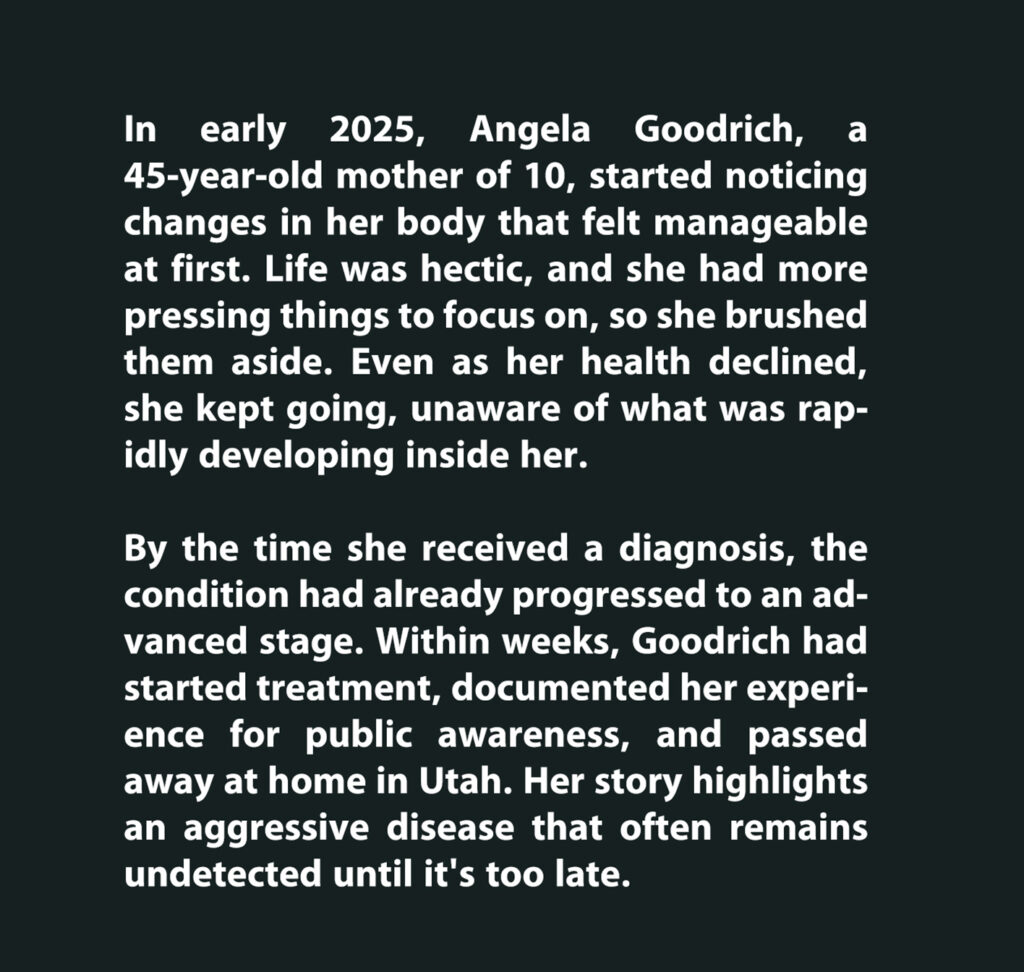
Family Life Before the Illness
Angela lived in Toquerville, Utah, with her husband, Matt Goodrich. The two met in high school and remained together ever since, raising a large family rooted in shared faith and commitment. Angela gave birth to 10 children, nine daughters and one son, whose ages ranged from 7 to 26 at the time of her death. Eight of them still lived at home.
The Goodrich family had recently welcomed new life into the fold. Their son and his wife, Maddie, became parents to twin boys, who had just turned one. Angela and Matt had officially become grandparents.
Angela’s life revolved around her family and community. She was active and present in the lives of her children and grandchildren, maintaining friendships and offering help to those around her. Nothing about her day-to-day life gave any indication that a serious illness was taking root.
Initial Physical Changes and Assumptions
In early 2025, Angela began noticing subtle changes in her body. She experienced a persistent sensation of fullness in her belly and visible swelling in her legs. At first, she believed the symptoms were related to stopping a medication she had been taking to manage polycystic ovarian syndrome (PCOS).
Matt also observed the changes in his wife’s condition. “The swelling was pretty bad,” he recalled. Despite these developments, there was no immediate sense of alarm. Angela carried on with her responsibilities, attributing the discomfort to something temporary or hormonal.
With no serious suspicions and no precedent, the possibility of cancer was not considered at this stage.
Worsening Symptoms During a Cruise
As the family prepared for a cruise earlier in the year, Angela’s symptoms began to intensify. During the trip, Matt noticed his wife struggling with activities that had never posed a challenge before. She was short of breath while climbing stairs and complained of abdominal pain.
Looking back, Angela recalled a moment just before they departed for the cruise when she had a sudden thought that her symptoms might be something serious. “But I just kind of shook it off out of my mind. We’re not doing that kind of thing,” she recalled.
Despite the discomfort, Angela didn’t let on to her family that she was overly concerned. Despite her optimism, a family member persuaded her to seek medical attention. That decision came just in time.
Visit to Urgent Care and Abnormal Results
In early March 2025, Angela followed through on a promise she had made to a relative and visited an urgent care clinic. Blood tests were performed during the appointment, and the results raised immediate concern. Her potassium levels were found to be dangerously low.
A doctor advised her to go directly to the emergency room for an intravenous infusion of potassium. Further testing was ordered, including a CT scan. It was during this ER visit that Angela first heard the word “tumor” used in reference to her condition.
Recalling that moment, she said, “An ER doctor came in and just kind of said, ‘Tumor this’ and ‘Tumor that.’ That’s how we found out.” What had started as vague and manageable symptoms now had a name, though the full scope of the illness had yet to be revealed.
Diagnosis: Stage 4 Adrenocortical Carcinoma
Following the CT scan, Angela was diagnosed with Stage 4 adrenocortical carcinoma (ACC). It is a rare and aggressive cancer that begins in the adrenal cortex, the outer layer of the adrenal glands located above each kidney.
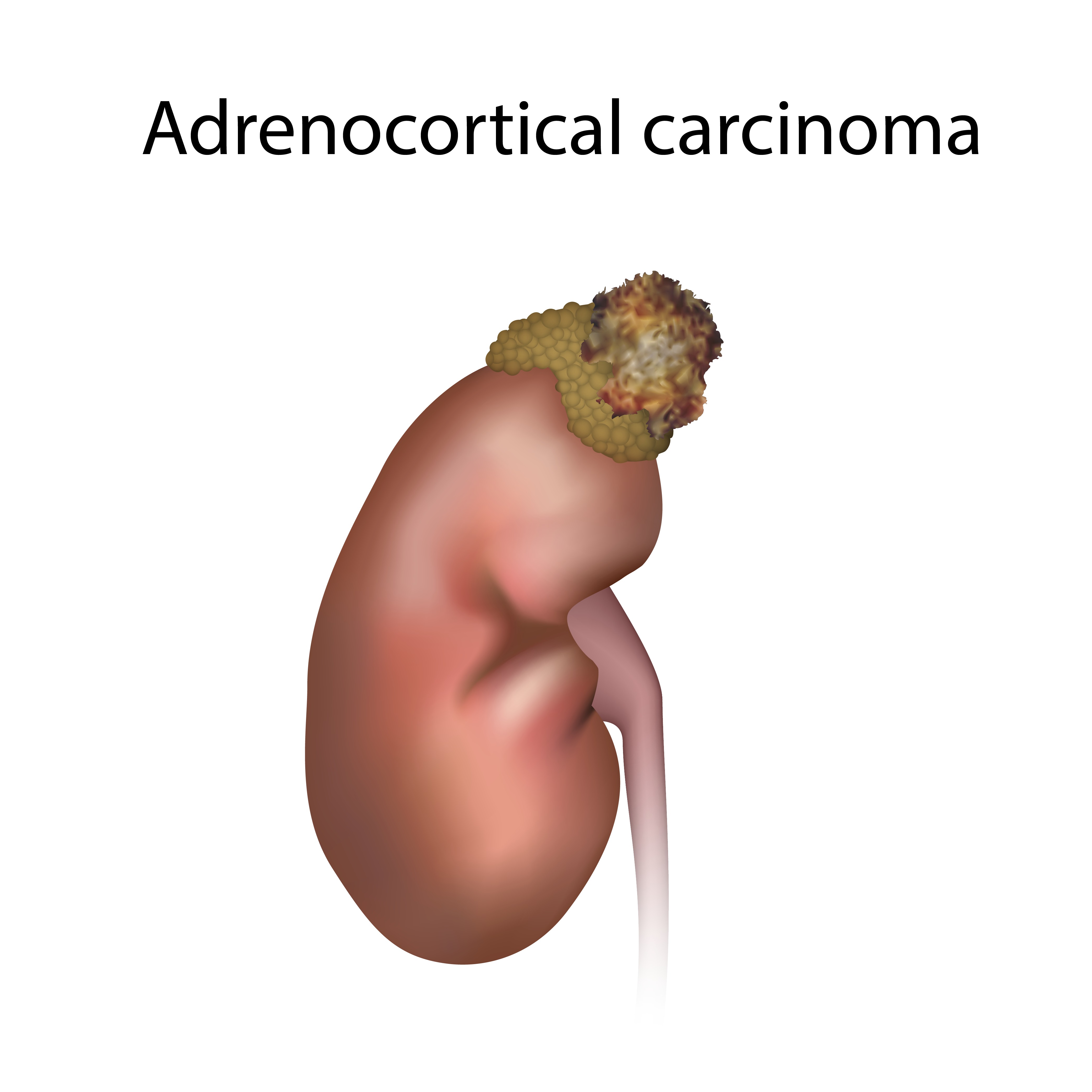
Illustration of adrenocortical carcinoma | Source: Getty Images
These glands produce hormones that regulate blood pressure, stress response, metabolism, and sexual characteristics. ACC is extremely rare, with only about one case per million people diagnosed in the U.S., according to the National Cancer Institute.
It occurs more frequently in women and can be especially difficult to detect early. The disease is often mistaken for more common adrenal tumors, such as adrenocortical adenomas, which are benign. Because the two types of tumors can appear similar under a microscope, proper diagnosis is critical.
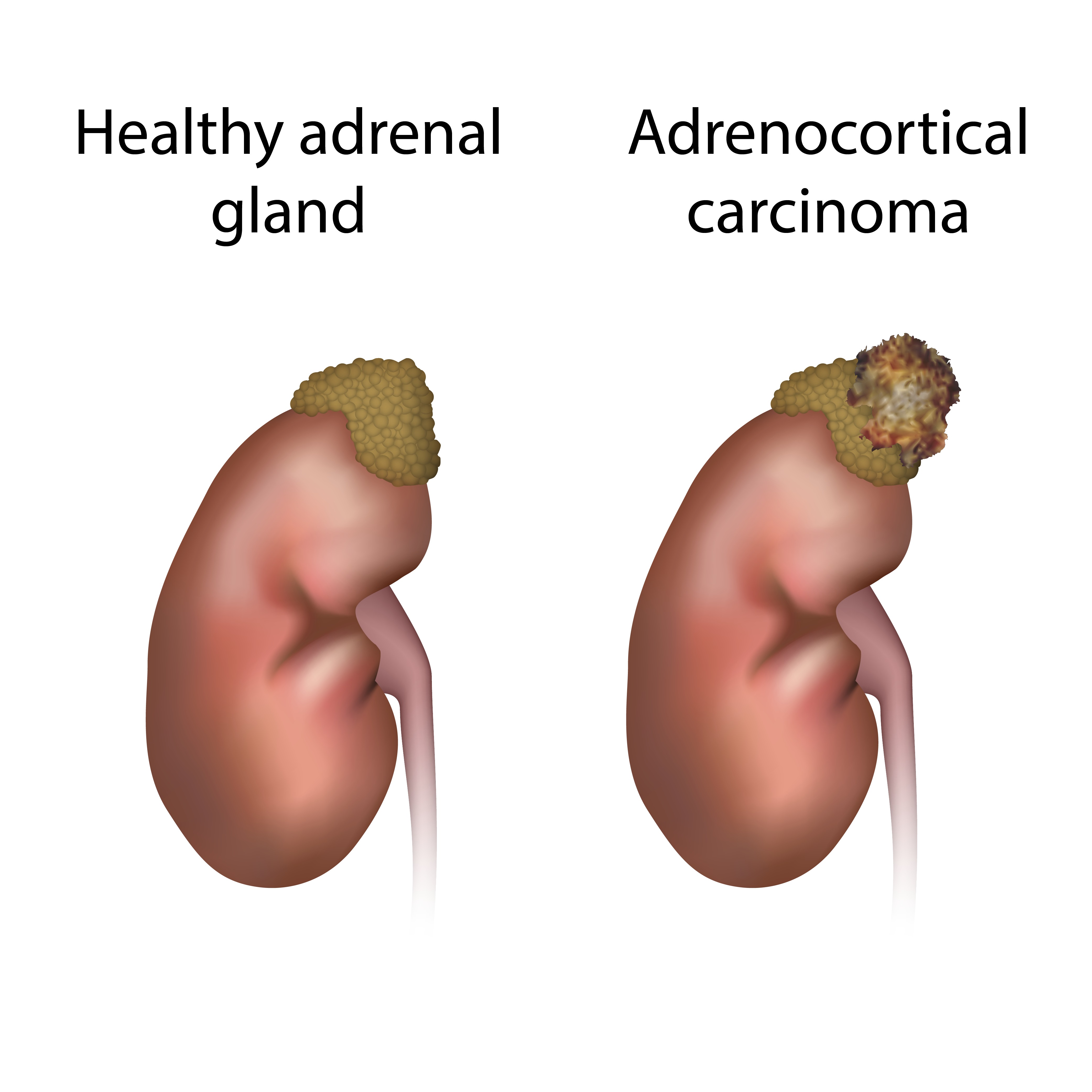
Illustration comparing adrenocortical carcinoma with a healthy adrenal gland, highlighting the differences in structure and appearance | Source: Getty Images
ACC tumors can be classified as either functioning or non-functioning. Functioning tumors produce excess hormones like cortisol, aldosterone, estrogen, or testosterone, which can cause a wide range of symptoms. Non-functioning tumors do not alter hormone levels and may remain undetected for longer.
Angela’s tumor was functioning. Her cortisol levels were extremely high, which led to the development of Cushing syndrome. This condition causes distinct symptoms, including a round and full face, weight gain, fat accumulation around the abdomen and upper back, back and bone pain, and mental symptoms such as confusion.
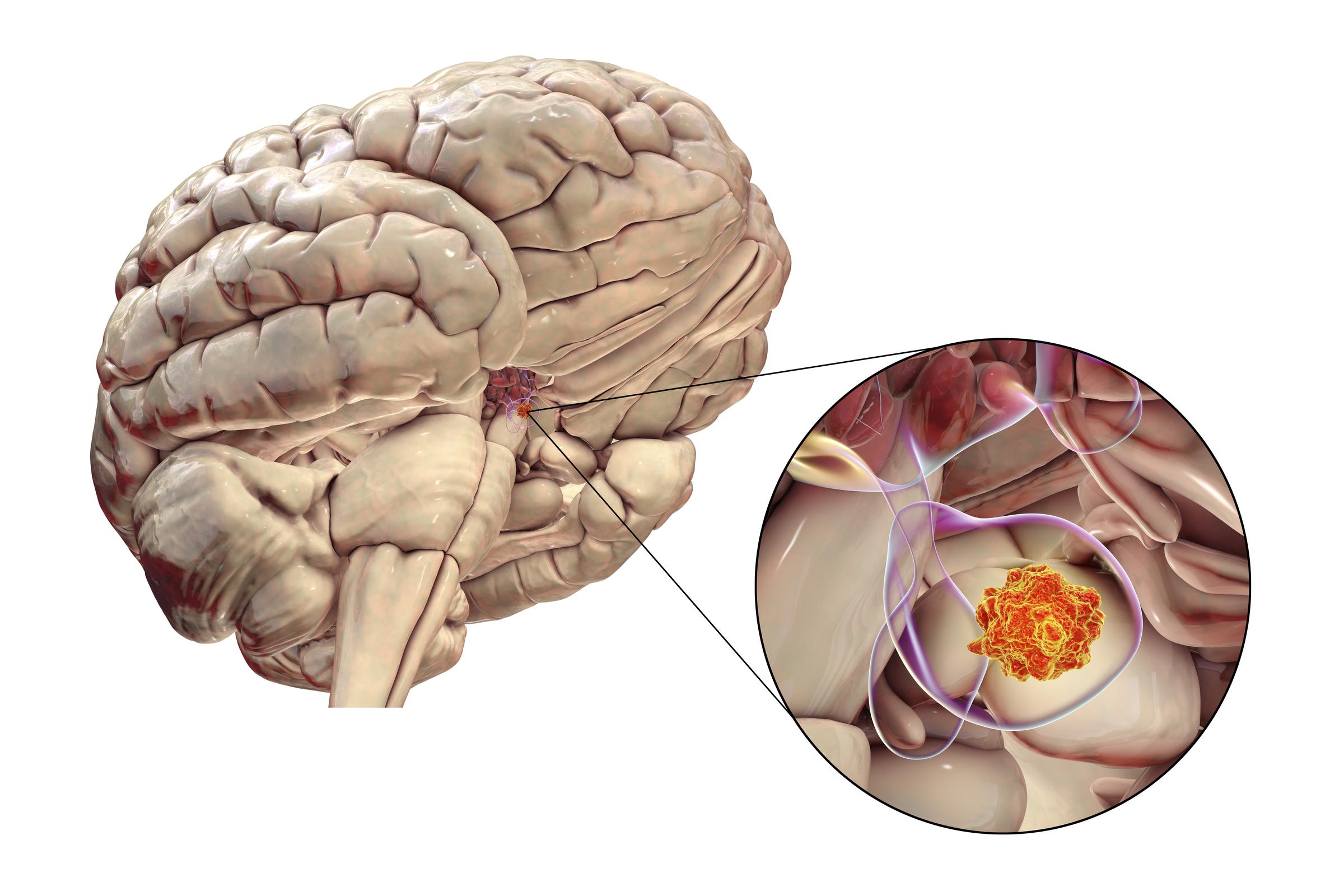
Computer-generated illustration of a pituitary gland tumor, highlighting its location and impact on surrounding structures | Source: Getty Images
Imaging revealed a tumor the size of a baseball on her adrenal gland. Additional tumors had already spread to her liver and lungs. In her lungs, the tumors ranged in size from marbles to golf balls. The cancer was growing quickly, and her body was already under strain before any treatment began.
This disorder can cause a round, full face, weight gain, fat buildup in the midsection, back and bone pain, and confusion, symptoms Angela had begun to experience.
Though ACC is hereditary in about 50% of cases, Angela reported no known family history of the disease. With multiple organs affected and significant hormonal disruption, her cancer was classified as advanced and aggressive.
Treatment options were limited by how far the disease had already progressed at the time of diagnosis.
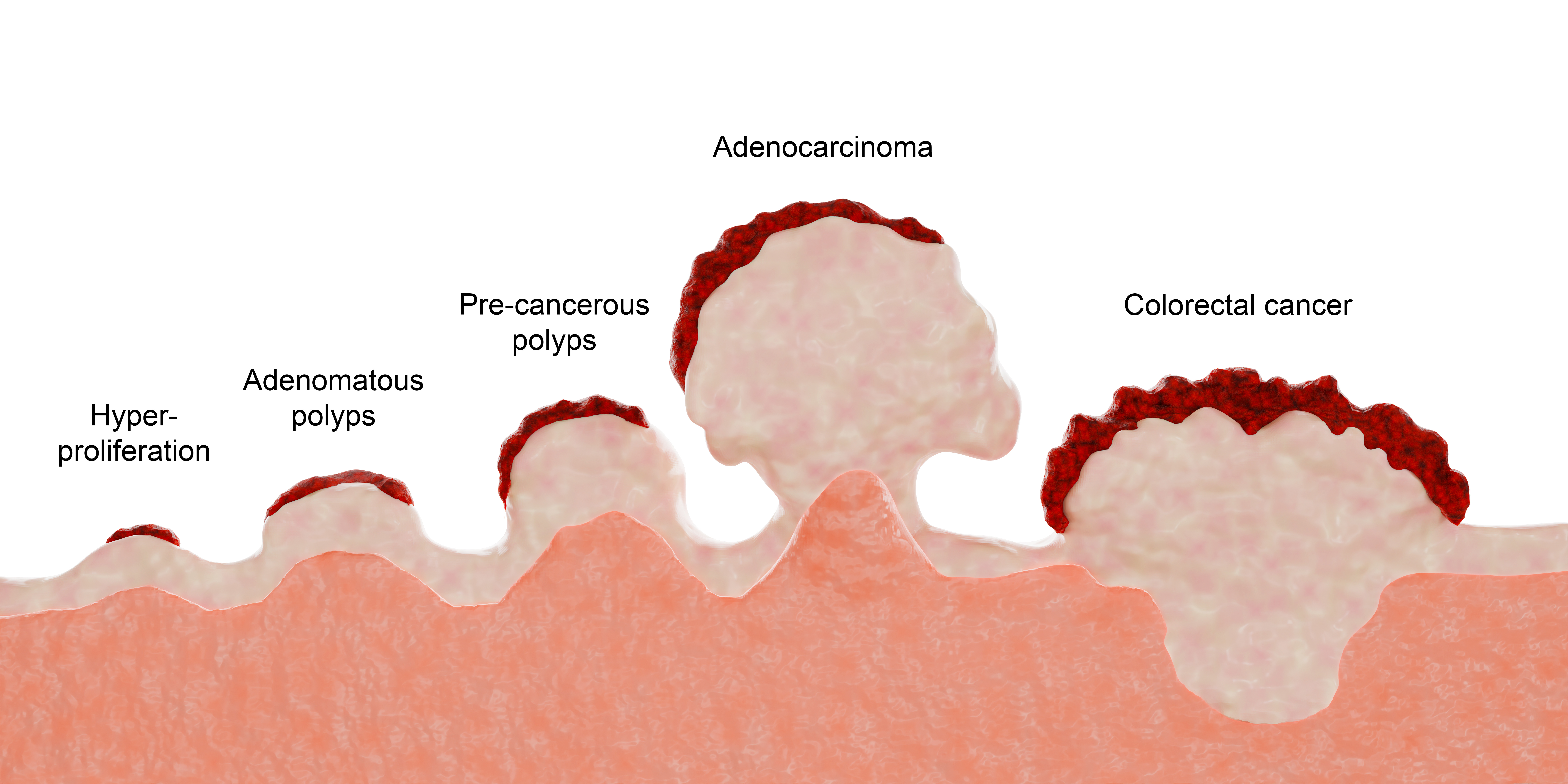
Illustration depicting the stages of colorectal cancer tumor development. The advanced stages, including adenocarcinoma, represent the transformation into a fully malignant condition | Source: Getty Images
Beginning Treatment and Community Support
Angela began chemotherapy just before Easter 2025. By that point, her condition was already advanced. According to Matt, her body had started to fail even before treatment could take effect. She was exhausted after the first round of chemotherapy, but still wanted to do more.
Despite her deteriorating health, she agreed to be interviewed in hopes of bringing awareness to the disease. “It was definitely a huge shock … [but] we’re going to get it figured out,” she told Today magazine shortly before her death.
Even though Angela’s cancer had few viable treatment options, she and Matt pursued everything they could. They explored holistic therapies in hopes of easing symptoms and extending quality of life. To help cover the overwhelming costs, the family’s relatives launched a GoFundMe campaign.
The fundraiser was intended to offset expenses related to medical care, holistic treatments, medication, and the other financial burdens that accompany late-stage cancer. In their message to supporters, the family emphasized that Angela and Matt were the kind of people who always gave back.
The GoFundMe also noted the emotional toll of the diagnosis, writing, “Nothing prepares you for the shock, emotional and financial toll this diagnosis would bring.” The campaign called for both financial contributions and prayers, asking the public to join the family in staying hopeful during an unthinkable time.
Support poured in from all directions. Friends, neighbors, and members of the community brought meals, helped clean the house, and sent messages of encouragement. Angela expressed her appreciation for this wave of kindness the day before she died.
“I really appreciate all the support and love we’ve received from the community and friends and family, and just from everywhere. So a lot of gratitude,” she said in her interview. Angela used what time she had left to make sure others could learn from her experience.
“I think sharing in a journey binds people together and gives the information out to help other people as well,” she explained. Her aim was not just to fight the disease, but to leave behind something that might help someone else recognize the signs sooner.
Her Final Day and the Legacy She Left Behind
Angela gave her interview on Thursday, April 24, 2025. The following day, Friday, April 25, she passed away at home in Toquerville, Utah, surrounded by her husband, Matt, and their 10 children. “It was a peaceful experience,” Matt said. “We are so blessed to have had her in our life [sic].”
Angela’s passing left a deep impact on those who knew her. One of her close friends, Blohm, shared that Angela had been the first person she met after moving into the Eagle Mountain neighborhood. She remembered an early moment that reflected Angela’s generosity.
Blohm had sent her daughter to Angela’s house for a single egg. Angela gave her a full dozen, saying, “Honey, if you needed one, you needed a dozen.” She added that Angela still had eight children living at home, and that one of her adult children had recently returned from a mission.
Blohm reflected on her sense of loss, “I think about my own grief and how badly I feel about maybe not having her in my life, and I just can’t even imagine what it would be like for her husband and kids right now. It just doesn’t seem like something like this should happen to someone so good. We just need her.”
Angela’s family, friends, and community remember her for the generosity, strength, and clarity she showed until the very end. Through her voice and the loved ones she left behind, her story continues to be shared.
Source: https://news.amomama.com/


